|
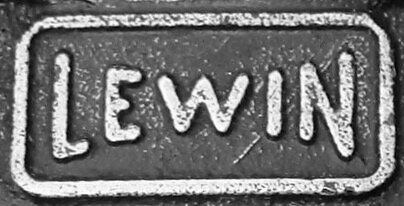
The Lewin Improved Universal or Six Fifteen light combination plane is something of an oddity, but there are a lot of them about and given the number of enquiries I get about it a page of its own seemed called for. Plus a certain spark of patriotic pride for this proudly claimed "All British" plane might have something to do with it too... Move over Stanley and Record, it's the Lewin's turn to star!
|

|
The Lewin is on a par with the Record 050 and Stanley 50; ploughing, beading and tongue & groove cutters being those supplied. Where it really differs, apart from its retro funky looks, is the majority of its construction being in aluminium. Thus it weighs a mere 3.5lbs. |

|
Earlier models came with 18 cutters, apparently increasing to 19 later; stored, edge uppermost, in a block in one corner of the box. I've been bitten by that means of storage too often to be keen on it, so be warned. The box itself often survives, possibly because of the blade storage and also it's big enough to accept the plane in its assembled state, but the lid is frequently awol. Mine is of 3/8" pine, 12 3/8" x 9" x 6 1/4" deep, pinned rebates. I've seen other examples that appear to be dovetailed. |
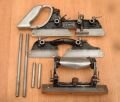
|
The main parts of the plane comprise the main stock, sliding section, both with steel skates secured to the aluminium body, and beech-faced fence with fine adjustment. The main stock, and longest part, is 11" long. The standard rods or arms are 8" long; I also have a set 3" long, but I've no idea whether they were offered as standard at one time, or available to order along with longer arms. (EDIT: Subsequently I discovered I'm an idiot - they're the short rods for a Record 044. D'oh...) The fence face is 1 1/4" deep with a range of fine adjustment of 3/8". |

|
One other novel feature of the Lewin is the means of securing all adjustments. Rather than assorted thumb screws and bolts, the Lewin uses a sort of cam affair. They work surprisingly well but unfortunately have nothing to keep them with the plane if they're not bearing on anything - they simply drop out. Something to check for if you're buying one; I didn't and was missing two, but luckily they're fairly easy to replicate with some steel rod, file, drill and a nail for the lever. Can you tell which is mine...? Yeah, thought you could. Ugly, but it works. |
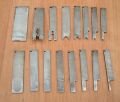
|
My Lewin is missing 2 blades, judging by the scrap of label left on the box. As far as I can gather the 18 standard cutters were plough 1/8" to 15/16", fillister 1 1/4", beading in 1/4", 5/16",3/8", 1/2" and 5/8", and T&G or Matching cutters of 3/16" and 1/4". |
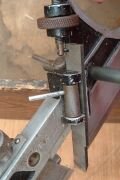
|
They're a little different from the usual Stanley/Record blades in being reduced in body width for the larger sizes, usually to around 1/2" wide, but with a little variation. There doesn't seem to be any actual reason why this should be so; yes, the cutter clamping area is only about 1/2" wide, but any wider blade wouldn't apparently foul on anything. Depth of cut is as much as 7/8". |

|
The depth stop has fine adjust, clamped with another cam-type locking doodah of course. The spur cutters are a basic one-way-up and they'll cut, other way up for no cut. There's no depth adjustment possible to allow for wear. |
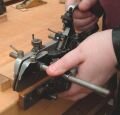
|
The earliest information I ever found on the Lewin was from Trevor Robinson writing on the Old Tools List on 31st May 1998.
"The best information I have found is in letters to the Editor of Woodworker for January 1984, pp. 58-59. The information there is that it was introduced about 1947 by Oxted Mill, Surrey, and was wholesaled by Buck and Hickman. Six fifteen refers to the price, which was 6 pounds 15 shillings. I have seen several of them sold, generally for less than the price of a Stanley 45. I think that I paid $85. for mine about ten years ago. It is a good user plane, more comfortable to handle than a 45. Although the range of cutters supplied with it is smaller than what was available for the Stanley, it does include all the usual plough and beading cutters."
|

|
Subsequently the beta release of this page dragged into my ken. Trouble is my own few primary sources aren't always agreeing with it, so I can't honestly suggest you take it as absolutely accurate, although parts certainly are. The debut year of 1947 seems to be backed up by Oxted Mill's 10,000 satisfied users quote though, which is something.
The earliest advert I have is one from The Woodworker, September 1950, and at 6 pounds, 19 shillings and 6 pence doesn't entirely embrace the "Six Fifteen" marketing idea. Perhaps the cost of the carriage spoilt it...
|

|
Exactly a year later, Tyzack's ad in The Woodworker of September 1951 shows the price has rocketed to 8 pounds, 12 shillings and 6 pence. "Lewin 8126" anyone? |
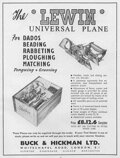
|
Buck & Hickman also offered it at the higher price in January 1952, which is the only example of their advert I have. Not a mention of it has been found in the B&H catalogues from 1935, 1953, 1958 or 1964. Its absence from most of them is understandable, but not a word in the '53 edition seems curious indeed. Unfortunately British Planemakers, my go-to reference book, similarly has not a word, but that's by the by. |
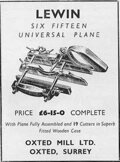
|
Meanwhile, in The Woodworker of February, April, May and October 1954 the Lewin was now - at last - being advertised as the Six Fifteen, had come down to that price of 6 pounds 15 shillings, gained an extra cutter (type or size unknown) and is being offered by Oxted Mill without a murmur about Buck & Hickman or Tyzack. What happened? Did Oxted Mill decide they could do better selling direct, enabling them to cut out the middle man and thus reduce the price? I have no idea and can't narrow down the dates with any accuracy until more information is forthcoming. The design of box label seems to have changed quite a bit too, which might also help with a more accurate timeline, but without even one complete label to my name, I'm thwarted. Frustrating, ain't it? And why was it called the Lewin anyway? No idea.
But if you think you might have info on this and other mysteries of this quirky plane, please do drop me a line. I'll be embarassingly grateful... |

|
The one thing I do have is a PDF of the manual, generously supplied by Laurent Heyraud. It's 1.3Mb, for the bandwidth-challenged. Click on the pic and get those Lewins making shavings, like the tool gods intended. It's a jolly good user plane. |
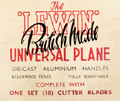
|
Edited to add a cleaned up version of one of the box labels. I admit it, I swiped it from a dealer's site. But hey, they swiped an uncredited copy of the manual from here first, so I reckon we're quits. |
Well there it is, all I know. One final thing; please don't email asking me what yours is worth. Your best bet for a accurate valuation is to look and see if there are any listed in the completed auctions on that well-known electronic auction house - it's what I'd have to do if you asked me anyway. Be warned, a bit like the Record #050, the prices can be all over the map; you won't truly know its worth until you sell it. But don't sell it; it's a nice plane!
Alf - 14th July 2006
|

